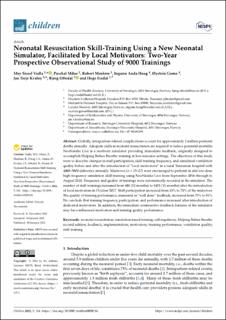| dc.contributor.author | Vadla, May Sissel | |
| dc.contributor.author | Mdoe, Paschal Francis | |
| dc.contributor.author | Moshiro, Robert Deogratias | |
| dc.contributor.author | Haug, Ingunn Anda | |
| dc.contributor.author | Gomo, Øystein | |
| dc.contributor.author | Kvaløy, Jan Terje | |
| dc.contributor.author | Oftedal, Bjørg Synnøve Frøysland | |
| dc.contributor.author | Ersdal, Hege Langli | |
| dc.date.accessioned | 2022-02-02T09:47:08Z | |
| dc.date.available | 2022-02-02T09:47:08Z | |
| dc.date.created | 2022-01-21T08:33:55Z | |
| dc.date.issued | 2022-01 | |
| dc.identifier.citation | Vadla, M.S., Mdoe, P., Moshiro, R., Haug, I.A., Gomo, Ø., Kvaløy, J.T., Oftedal, B., & Ersdal, H. (2021) Neonatal Resuscitation Skill-Training Using a New Neonatal Simulator, Facilitated by Local Motivators: Two-Year Prospective Observational Study of 9000 Trainings. Children, 9(2), 134 | en_US |
| dc.identifier.issn | 2227-9067 | |
| dc.identifier.uri | https://hdl.handle.net/11250/2976598 | |
| dc.description.abstract | Globally, intrapartum-related complications account for approximately 2 million perinatal deaths annually. Adequate skills in neonatal resuscitation are required to reduce perinatal mortality. NeoNatalie Live is a newborn simulator providing immediate feedback, originally designed to accomplish Helping Babies Breathe training in low-resource settings. The objectives of this study were to describe changes in staff participation, skill-training frequency, and simulated ventilation quality before and after the introduction of “local motivators” in a rural Tanzanian hospital with 4000–5000 deliveries annually. Midwives (n = 15–27) were encouraged to perform in situ low-dose high-frequency simulation skill-training using NeoNatalie Live from September 2016 through to August 2018. Frequency and quality of trainings were automatically recorded in the simulator. The number of skill-trainings increased from 688 (12 months) to 8451 (11 months) after the introduction of local motivators in October 2017. Staff participation increased from 43% to 74% of the midwives. The quality of training performance, measured as “well done” feedback, increased from 75% to 91%. We conclude that training frequency, participation, and performance increased after introduction of dedicated motivators. In addition, the immediate constructive feedback features of the simulator may have influenced motivation and training quality performance. | en_US |
| dc.language.iso | eng | en_US |
| dc.publisher | MDPI | en_US |
| dc.rights | Navngivelse 4.0 Internasjonal | * |
| dc.rights.uri | http://creativecommons.org/licenses/by/4.0/deed.no | * |
| dc.subject | pediatri | en_US |
| dc.subject | nyfødtgjenoppliving | en_US |
| dc.subject | neonatal resuscitation | en_US |
| dc.subject | simuleringsbasert trening | en_US |
| dc.title | Neonatal Resuscitation Skill-Training Using a New Neonatal Simulator, Facilitated by Local Motivators: Two-Year Prospective Observational Study of 9000 Trainings | en_US |
| dc.type | Peer reviewed | en_US |
| dc.type | Journal article | en_US |
| dc.description.version | publishedVersion | en_US |
| dc.rights.holder | © 2022 by the authors | en_US |
| dc.subject.nsi | VDP::Medisinske Fag: 700::Klinisk medisinske fag: 750::Pediatri: 760 | en_US |
| dc.source.volume | 9 | en_US |
| dc.source.journal | Children | en_US |
| dc.source.issue | 2 | en_US |
| dc.identifier.doi | 10.3390/children9020134 | |
| dc.identifier.cristin | 1987054 | |
| dc.source.articlenumber | 134 | en_US |
| cristin.ispublished | true | |
| cristin.fulltext | original | |
| cristin.qualitycode | 1 | |

